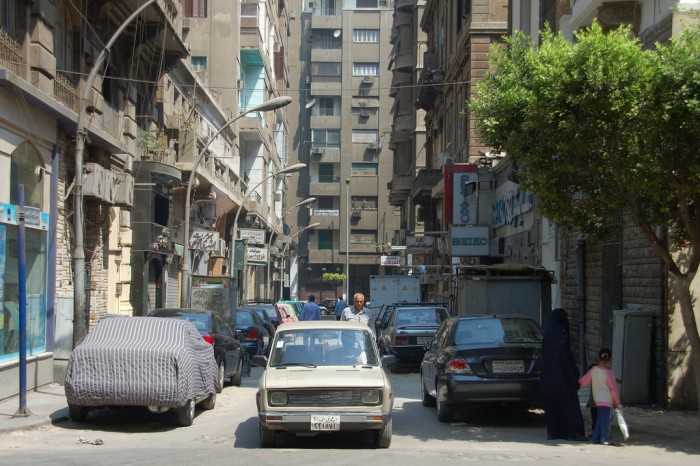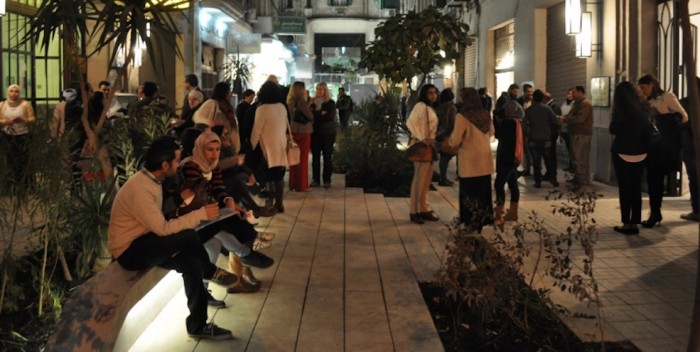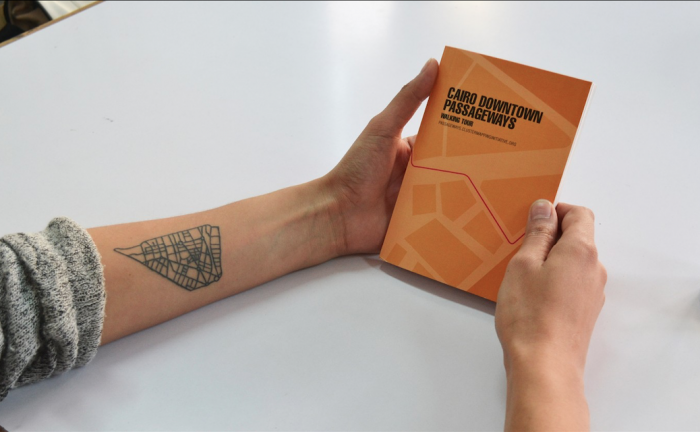The city of Cairo is in a state of deterioration, says city planner Omar Nagati. We’re speaking in his mercifully air-conditioned office after making our way out of the hordes of people and cars competing for space in the 40-degree heat of the streets below.
Like many spaces in Downtown Cairo, Nagati’s headquarters is indistinguishable from the buildings that surround it – its doorway obscured as it blends with the general dilapidation of Sherif Pasha Street. Here, there’s a visible relationship between the formal and the informal.
While street traders occupy the ground floors, side streets and alleyways, boarded up windows and chipped paint on the upper storeys belie formal businesses within. For an organisation of urban planners and social researchers like Nagati’s Cluster, infrastructure like this – sometimes even built by the people themselves – is the status quo.
“Cairo is a city where more than two-thirds is built informally,” says Nagati. “So the informal process here is not the state of exception; it’s the mainstream.”
It’s through the narrow streets and back alleys of Downtown Cairo that Cluster is able to engage with local people and stakeholders to push an agenda of inclusive city planning.
An alley in Downtown Cairo - Image Courtesy of David Evers
In August, we travelled to Egypt and Morocco to find the designers responding to social issues through design in North Africa. After the Arab Spring in 2011 and the political instability that followed, journalists and creatives found a home in Downtown Cairo.
Graffiti lined the walls of the crumbling buildings, and old cafes and bars became the birthing places of revolutionary thinkers – out of sight of a then weakened regime but close enough to the iconic Tahrir Square. As Nagati recalls, they knew this moment of flux would be short-lived. It was up to designers to capitalise on this fleeting opportunity to bring about tangible change.
“The state was very weak and there was a very empowered sense of community, and people were taking to the streets and changing things on the ground. We knew that this is a temporary condition and that the State would eventually come back,” he says. “We wanted to discuss, how can we use this moment of suspension of order, this political vacuum. And what would people do if they were left to organise their streets and their neighbourhoods? And how can we as architects and planners learn from this informality, this informal order?”
One of the first projects to take root was Cairo Downtown Passages, an urban design and art project that reimagines Downtown’s public spaces to promote more diverse, inclusive, and accessible areas. Conceptualised during a collaborative workshop in 2014, two pilot projects were launched: the Kodak Passage and the Philips Passage. The former is a “Green Oasis” which transforms Kodak into a pedestrian park, while the latter is a “Light Oasis” in Philips, which brings marquee lighting and the possibility for film screenings to a previously dark and decaying space.
“The design is fairly simple,” explains Nagati. “We’re using it [passageways] to bring nature back into downtown. So we added a little bit of a green oasis or an urban garden. The idea is to try to mediate the public and private sphere. As you can see in Cairo, there’s a lot of spillover from shops onto the street but also street vendors and informal traffic organisation. So the public and private domain are not very clearly demarcated as they are in Northern Europe for example.”
Ultimately, the project, as evidenced by its small scale, is an attempt to look at the microcosm of the city. The idea, says Nagati, is to question how urban planners can negotiate, through design, the competing interests and competing claims to the city. “As you walk you have to negotiate your right to the street. From a gender perspective, from a class perspective, from a culture perspective, there are different frames of reference for what you can and cannot do – it’s not necessarily what the law says. There are multiple layers of order that govern,” he adds.
The projects are a testing site for Cluster’s Cairo Downtown Passageways: Walking Tour publication which maps Cairo’s passageways, back alleys, side streets and in-between spaces as an alternative framework for the development and revitalisation of the city.
The city needs an alternative because like cities across the world, the revitalisation of an area is very likely to be code for gentrification. According to Nagati, it’s the role of civil society to establish an alternative before classic gentrification led by private enterprises takes hold.
“You need to include in any plan or revision for Downtown or any neighbourhood, the local community, which is not necessarily the case so far,” he says, pointing to two reasons why urban planning has so far excluded the local people.
Firstly, Egypt does not have a mechanism of participatory government in that locals have no local governmental departments through which to lobby for the changes they need. Secondly, plans to restore Downtown were undertaken after the revolution:
“You can see the buildings being painted. And that’s led by the government in partnership with private sector companies,” says Nagati. “Usually, these private sector companies are less concerned about the fine grain and more about the turnover of profit. And that’s their business, I’m not blaming them.”
The next step is to establish an art council that acts as a mediator between local people and the government, adds Nagati: “We want to have a body that represents the interests of civil society and arts and culture relations to talk to the government and say, we are the third leg of this triangle and it’s really actually your advantage that we thrive because we don’t only bring art and culture but we also bring business. Right now, we’re working on a study to assess the economic impact of the creative sector in Downtown and it’s huge.”
Next: Cairo’s underground youth & the gender divide in this growing subculture









